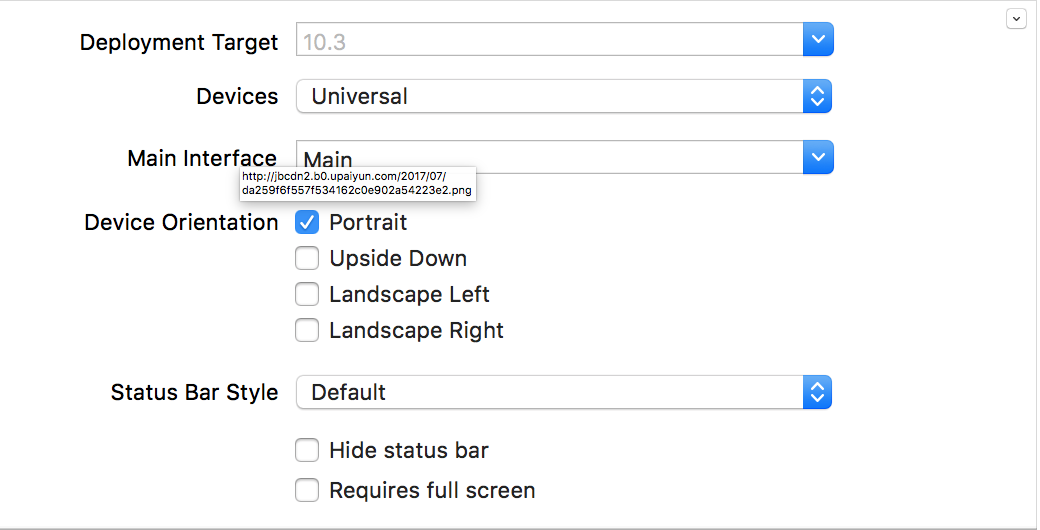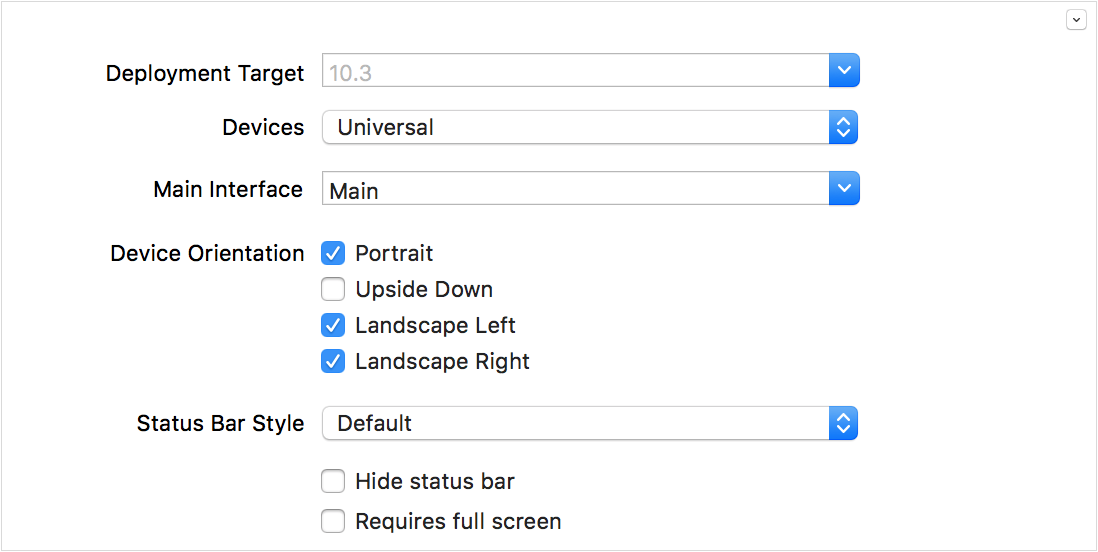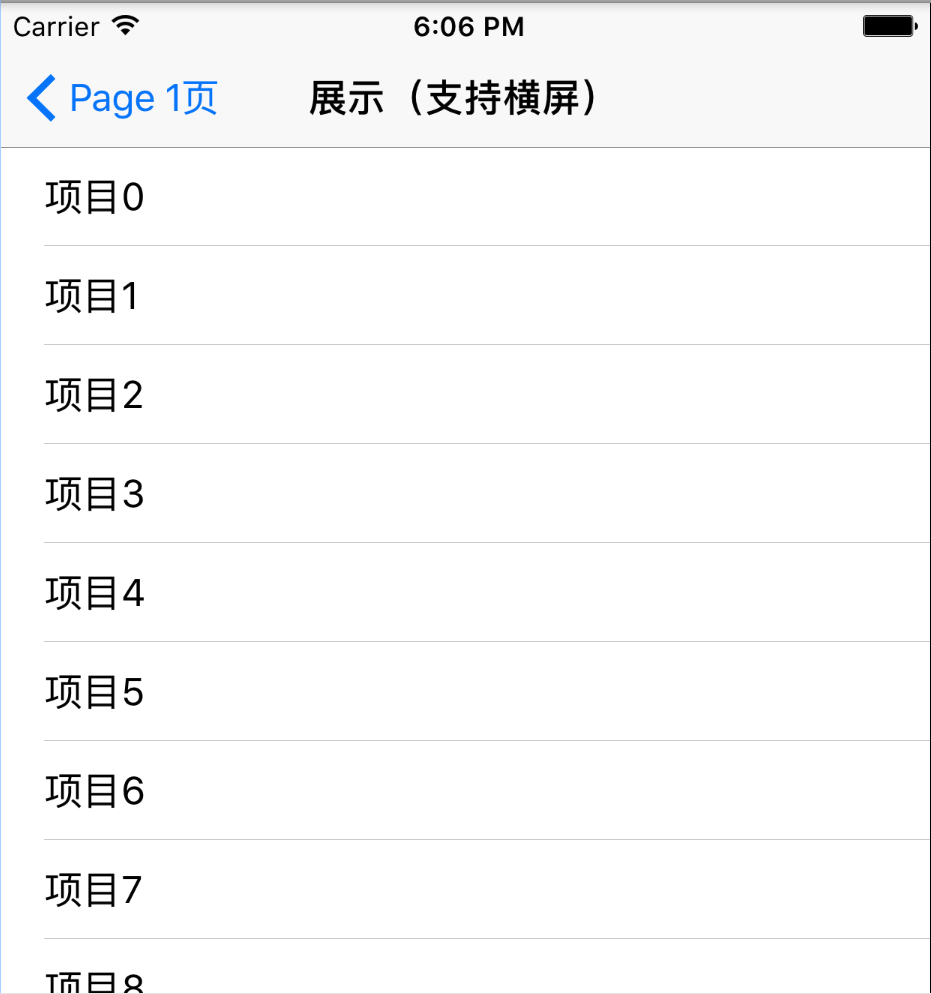程式碼處理 iOS 的橫豎屏旋轉
一、監聽螢幕旋轉方向
在處理iOS橫豎屏時,經常會和UIDeviceOrientation、UIInterfaceOrientation和UIInterfaceOrientationMask這三個列舉型別打交道,它們從不同角度描述了螢幕旋轉方向。
1、UIDeviceOrientation:裝置方向
iOS的裝置方向是通過iOS的加速計來獲取的。
1)iOS定義了以下七種裝置方向
typedefNS_ENUM(NSInteger, UIDeviceOrientation) {
UIDeviceOrientationUnknown, // 未知方向,可能是裝置(螢幕)斜置
UIDeviceOrientationPortrait, // 裝置(螢幕)直立
UIDeviceOrientationPortraitUpsideDown, // 裝置(螢幕)直立,上下顛倒
UIDeviceOrientationLandscapeLeft, // 裝置(螢幕)向左橫置
UIDeviceOrientationLandscapeRight, // 裝置(螢幕)向右橫置
UIDeviceOrientationFaceUp, // 裝置(螢幕)朝上平躺
UIDeviceOrientationFaceDown // 裝置(螢幕)朝下平躺
};
說明:UIDeviceOrientation參考home鍵方向,如:home方向在右,裝置(螢幕)方向向左(UIDeviceOrientationLandscapeLeft)
2)讀取裝置方向
UIDevice單例代表當前的裝置。從這個單例中可以獲得的資訊裝置,如裝置方向orientation。
UIDeviceOrientation deviceOrientation = [UIDevicecurrentDevice].orientation;
3)監聽、處理和移除 裝置方向改變的通知
當裝置方向變化時候,發出UIDeviceOrientationDidChangeNotification通知;註冊監聽該通知,可以針對不同的裝置方向處理檢視展示。
//開啟和監聽 裝置旋轉的通知(不開啟的話,裝置方向一直是UIInterfaceOrientationUnknown)
if (![UIDevicecurrentDevice].generatesDeviceOrientationNotifications) {
[[UIDevicecurrentDevice] beginGeneratingDeviceOrientationNotifications];
}
[[NSNotificationCenterdefaultCenter]addObserver:selfselector:@selector(handleDeviceOrientationChange:)
name:UIDeviceOrientationDidChangeNotificationobject:nil];
//裝置方向改變的處理
- (void)handleDeviceOrientationChange:(NSNotification *)notification{
UIDeviceOrientation deviceOrientation = [UIDevicecurrentDevice].orientation;
switch (deviceOrientation) {
caseUIDeviceOrientationFaceUp:
NSLog(@"螢幕朝上平躺");
break;
caseUIDeviceOrientationFaceDown:
NSLog(@"螢幕朝下平躺");
break;
caseUIDeviceOrientationUnknown:
NSLog(@"未知方向");
break;
caseUIDeviceOrientationLandscapeLeft:
NSLog(@"螢幕向左橫置");
break;
caseUIDeviceOrientationLandscapeRight:
NSLog(@"螢幕向右橫置");
break;
caseUIDeviceOrientationPortrait:
NSLog(@"螢幕直立");
break;
caseUIDeviceOrientationPortraitUpsideDown:
NSLog(@"螢幕直立,上下顛倒");
break;
default:
NSLog(@"無法辨識");
break;
}
}
//最後在dealloc中移除通知 和結束裝置旋轉的通知
- (void)dealloc{
//...
[[NSNotificationCenterdefaultCenter]removeObserver:self];
[[UIDevicecurrentDevice]endGeneratingDeviceOrientationNotifications];
}
說明:手機鎖定豎屏後,UIDeviceOrientationDidChangeNotification通知就失效了。
2、UIInterfaceOrientation:介面方向
介面方向是反應iOS中介面的方向,它和Home按鈕的方向是一致的。
1)iOS定義了以下五種介面方向
typedefNS_ENUM(NSInteger, UIInterfaceOrientation) {
UIInterfaceOrientationUnknown = UIDeviceOrientationUnknown, //未知方向
UIInterfaceOrientationPortrait = UIDeviceOrientationPortrait, //介面直立
UIInterfaceOrientationPortraitUpsideDown = UIDeviceOrientationPortraitUpsideDown, //介面直立,上下顛倒
UIInterfaceOrientationLandscapeLeft = UIDeviceOrientationLandscapeRight, //介面朝左
UIInterfaceOrientationLandscapeRight = UIDeviceOrientationLandscapeLeft //介面朝右
} __TVOS_PROHIBITED;
說明:從定義可知,介面方向和設別方向有對應關係,如介面的豎直方向就是 裝置的豎直方向:UIInterfaceOrientationUnknown = UIDeviceOrientationUnknown
2)讀取介面方向
UIInterfaceOrientation和狀態列有關,通過UIApplication的單例呼叫statusBarOrientation來獲取
UIInterfaceOrientation interfaceOrientation = [[UIApplicationsharedApplication] statusBarOrientation];
3)監聽、處理和移除 介面方向改變的通知
當介面方向變化時候,先後發出UIApplicationWillChangeStatusBarOrientationNotification和UIApplicationDidChangeStatusBarOrientationNotification通知;註冊監聽這兩個通知,可以針對不同的介面方向處理檢視展示。
//以監聽UIApplicationDidChangeStatusBarOrientationNotification通知為例
[[NSNotificationCenterdefaultCenter]addObserver:selfselector:@selector(handleStatusBarOrientationChange:)
name:UIApplicationDidChangeStatusBarOrientationNotificationobject:nil];
//介面方向改變的處理
- (void)handleStatusBarOrientationChange: (NSNotification *)notification{
UIInterfaceOrientation interfaceOrientation = [[UIApplicationsharedApplication] statusBarOrientation];
switch (interfaceOrientation) {
caseUIInterfaceOrientationUnknown:
NSLog(@"未知方向");
break;
caseUIInterfaceOrientationPortrait:
NSLog(@"介面直立");
break;
caseUIInterfaceOrientationPortraitUpsideDown:
NSLog(@"介面直立,上下顛倒");
break;
caseUIInterfaceOrientationLandscapeLeft:
NSLog(@"介面朝左");
break;
caseUIInterfaceOrientationLandscapeRight:
NSLog(@"介面朝右");
break;
default:
break;
}
}
//最後在dealloc中移除通知
- (void)dealloc{
//...
[[NSNotificationCenterdefaultCenter]removeObserver:self];
[[UIDevicecurrentDevice]endGeneratingDeviceOrientationNotifications];
}
說明:手機鎖定豎屏後,UIApplicationWillChangeStatusBarOrientationNotification和UIApplicationDidChangeStatusBarOrientationNotification通知也失效了。
3、UIInterfaceOrientationMask
UIInterfaceOrientationMask是為了整合多種UIInterfaceOrientation而定義的型別,和ViewController相關,一共有7種
1)iOS中的UIInterfaceOrientationMask定義
typedefNS_OPTIONS(NSUInteger, UIInterfaceOrientationMask) {
UIInterfaceOrientationMaskPortrait = (1 <<UIInterfaceOrientationPortrait),
UIInterfaceOrientationMaskLandscapeLeft = (1 <<UIInterfaceOrientationLandscapeLeft),
UIInterfaceOrientationMaskLandscapeRight = (1 <<UIInterfaceOrientationLandscapeRight),
UIInterfaceOrientationMaskPortraitUpsideDown = (1 <<UIInterfaceOrientationPortraitUpsideDown),
UIInterfaceOrientationMaskLandscape = (UIInterfaceOrientationMaskLandscapeLeft |UIInterfaceOrientationMaskLandscapeRight),
UIInterfaceOrientationMaskAll = (UIInterfaceOrientationMaskPortrait |UIInterfaceOrientationMaskLandscapeLeft |UIInterfaceOrientationMaskLandscapeRight |UIInterfaceOrientationMaskPortraitUpsideDown),
UIInterfaceOrientationMaskAllButUpsideDown = (UIInterfaceOrientationMaskPortrait |UIInterfaceOrientationMaskLandscapeLeft |UIInterfaceOrientationMaskLandscapeRight),
} __TVOS_PROHIBITED;
2)UIInterfaceOrientationMask的使用
在ViewController可以重寫- (UIInterfaceOrientationMask)supportedInterfaceOrientations方法返回型別,來決定UIViewController可以支援哪些介面方向。
//支援介面直立
- (UIInterfaceOrientationMask)supportedInterfaceOrientations{
returnUIInterfaceOrientationMaskPortrait;
}
總結:UIDeviceOrientation(裝置方向)和UIInterfaceOrientation(螢幕方向)是兩個不同的概念。前者代表了裝置的一種狀態,而後者是螢幕為了應對不同的裝置狀態,做出的使用者介面上的響應。在iOS裝置旋轉時,由UIKit接收到旋轉事件,然後通過AppDelegate通知當前程式的UIWindow物件,UIWindow物件通知它的rootViewController,如果該rootViewController支援旋轉後的螢幕方向,完成旋轉,否則不旋轉;彈出的ViewController也是如此處理。
二、檢視控制器中旋轉方向的設定
0、關於禁止橫屏的操作(不建議)
比較常規的方法有兩種。
方法1:在專案的General–>Deployment Info–>Device Orientation中,只勾選Portrait(豎屏)
勾選Portrait.png
方法2:Device Orientation預設設定,在Appdelegate中實現supportedInterfaceOrientationsForWindow:只返回UIInterfaceOrientationMaskPortraitt(豎屏)
- (NSUInteger)application:(UIApplication *)application supportedInterfaceOrientationsForWindow:(UIWindow *)window {
returnUIInterfaceOrientationMaskPortrait;
}
說明:極少的APP中所有介面都是豎屏的,因為總會有介面需要支援橫屏,如視訊播放頁。所以不建議設定禁止APP頁面橫屏。
下面介紹如何讓專案中的 檢視控制器中旋轉方向的設定
1、APP支援多個方向
APP支援多個方向.png
說明:如此,APP支援橫屏和豎屏了,但是具體檢視控制器支援的頁面方向還需要進一步處理。由於不支援豎屏顛倒(Upside Down),即使裝置上下顛倒,通過API也不會獲得裝置、螢幕上下顛倒方向的。
2、支援ViewController螢幕方向設定
1)關鍵函式
檢視控制器支援的介面方向主要由以下三個函式控制
//是否自動旋轉,返回YES可以自動旋轉,返回NO禁止旋轉
- (BOOL)shouldAutorotateNS_AVAILABLE_IOS(6_0)__TVOS_PROHIBITED;
//返回支援的方向
- (UIInterfaceOrientationMask)supportedInterfaceOrientationsNS_AVAILABLE_IOS(6_0)__TVOS_PROHIBITED;
//由模態推出的檢視控制器 優先支援的螢幕方向
- (UIInterfaceOrientation)preferredInterfaceOrientationForPresentationNS_AVAILABLE_IOS(6_0)__TVOS_PROHIBITED;
2) QSBaseViewController設定
//QSBaseViewController.h
@interface QSBaseController : UIViewController
@end
//QSBaseViewController.m
@implementation QSBaseController
//#pragma mark - 控制螢幕旋轉方法
//是否自動旋轉,返回YES可以自動旋轉,返回NO禁止旋轉
- (BOOL)shouldAutorotate{
returnNO;
}
//返回支援的方向
- (UIInterfaceOrientationMask)supportedInterfaceOrientations{
returnUIInterfaceOrientationMaskPortrait;
}
//由模態推出的檢視控制器 優先支援的螢幕方向
- (UIInterfaceOrientation)preferredInterfaceOrientationForPresentation{
returnUIInterfaceOrientationPortrait;
}
@end
說明1:QSBaseViewController預設不支援旋轉,只支援 介面豎直方向,專案中的Controller都繼承自QSBaseViewController,可以通過重寫這三個方法來讓Controller支援除豎屏之外的方向或旋轉。
3) 在QSNavigationController設定
目標:通過QSNavigationController來push檢視控制器時,把支援螢幕旋轉的設定交給最新push進來([self.viewControllers lastObject])的viewController來設定。
//QSNavigationController.h
@interface QSNavigationController :UINavigationController
@end
//QSNavigationController.m
@implementation QSNavigationController
#pragma mark - 控制螢幕旋轉方法
- (BOOL)shouldAutorotate{
return [[self.viewControllerslastObject]shouldAutorotate];
}
- (UIInterfaceOrientationMask)supportedInterfaceOrientations{
return [[self.viewControllerslastObject]supportedInterfaceOrientations];
}
- (UIInterfaceOrientation)preferredInterfaceOrientationForPresentation{
return [[self.viewControllerslastObject] preferredInterfaceOrientationForPresentation];
}
@end
4) 在QSTabBarController設定
目標:TabBarController通常作為整個程式的rootViewController,UITabBar上面顯示的每一個Tab都對應著一個ViewController;每點選一個Tab,出現的ViewController(self.selectedViewController)對螢幕旋轉和支援方向的設定 交給其自身去控制。
//QSTabBarController.h
@interface QSTabBarController :UITabBarController
@end
//QSTabBarController.m
@implementation QSTabBarController
#pragma mark - 控制螢幕旋轉方法
- (BOOL)shouldAutorotate{
return [self.selectedViewControllershouldAutorotate];
}
- (UIInterfaceOrientationMask)supportedInterfaceOrientations{
return [self.selectedViewControllersupportedInterfaceOrientations];
}
- (UIInterfaceOrientation)preferredInterfaceOrientationForPresentation{
return [self.selectedViewControllerpreferredInterfaceOrientationForPresentation];
}
@end
三、螢幕旋轉方向下的檢視處理
1、螢幕旋轉時,建議監聽UIApplicationDidChangeStatusBarOrientationNotification
原因1:supportedInterfaceOrientations方法中最終返回的是多個介面方向。
原因2(最重要的原因):我們真正要處理的是頁面方向發生旋轉UI的變化。而在裝置的物理方向發生旋轉的時候,如果此時當前控制器的頁面並沒有旋轉,我們這時改變UI佈局,可能就發生問題了。
2、螢幕的寬高處理
1)在iOS 8之後,當螢幕旋轉的時候,[[UIScreenmainScreen]bounds]也發生了改變。如橫屏時候的螢幕寬度 其實是豎屏的時候螢幕的高度。
2)我們處理檢視佈局時候,如果使用到螢幕的寬高,不要直接使用SCREEN_HEIGHT和SCREEN_WIDTH,而使用SCREEN_MIN和SCREEN_MAX
#define SCREEN_HEIGHT CGRectGetHeight([[UIScreen mainScreen] bounds])
#define SCREEN_WIDTH CGRectGetWidth([[UIScreen mainScreen] bounds])
#define SCREEN_MIN MIN(SCREEN_HEIGHT,SCREEN_WIDTH)
#define SCREEN_MAX MAX(SCREEN_HEIGHT,SCREEN_WIDTH)
說明:豎屏時候,寬是SCREEN_MIN,高是SCREEN_MAX;橫屏時候,寬是SCREEN_MAX,高是SCREEN_MIN。
3、螢幕旋轉下處理Demo
//監聽UIApplicationDidChangeStatusBarOrientationNotification的處理
- (void)handleStatusBarOrientationChange: (NSNotification *)notification{
UIInterfaceOrientation interfaceOrientation = [[UIApplicationsharedApplication] statusBarOrientation];
BOOL isLandscape =NO;
switch (interfaceOrientation) {
caseUIInterfaceOrientationUnknown:
NSLog(@"未知方向");
break;
caseUIInterfaceOrientationPortrait:
caseUIInterfaceOrientationPortraitUpsideDown:
isLandscape = NO;
break;
caseUIInterfaceOrientationLandscapeLeft:
caseUIInterfaceOrientationLandscapeRight:
isLandscape = YES;
break;
default:
break;
}
if (isLandscape) {
self.tableView.frame = CGRectMake(0,0, SCREEN_MAX, SCREEN_MIN -44);
}else{
self.tableView.frame = CGRectMake(0,0, SCREEN_MIN, SCREEN_MAX -64);
}
[self.tableView reloadData];
}
說明:當然也可以選擇使用Masonry這樣優秀的AutoLayout佈局第三方庫來處理,storyBoard來佈局次之。
4、螢幕旋轉下處理Demo效果圖
豎屏下效果.png
橫屏下效果.png




